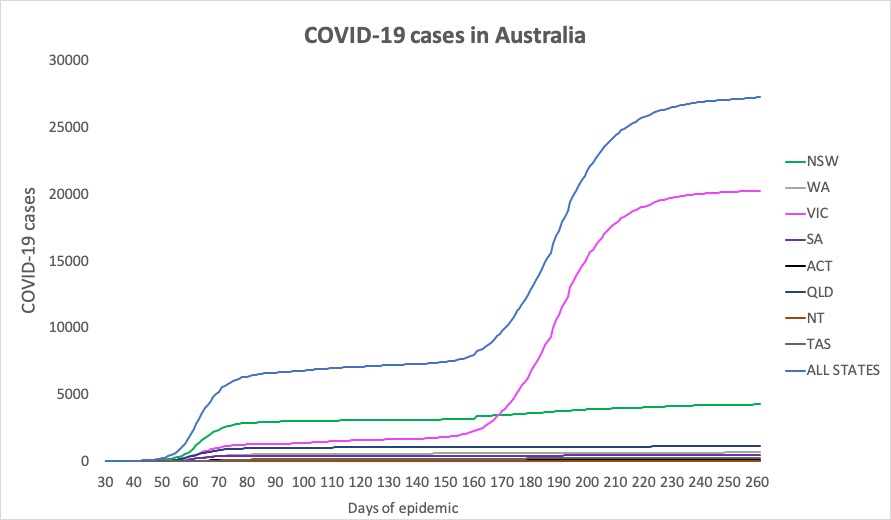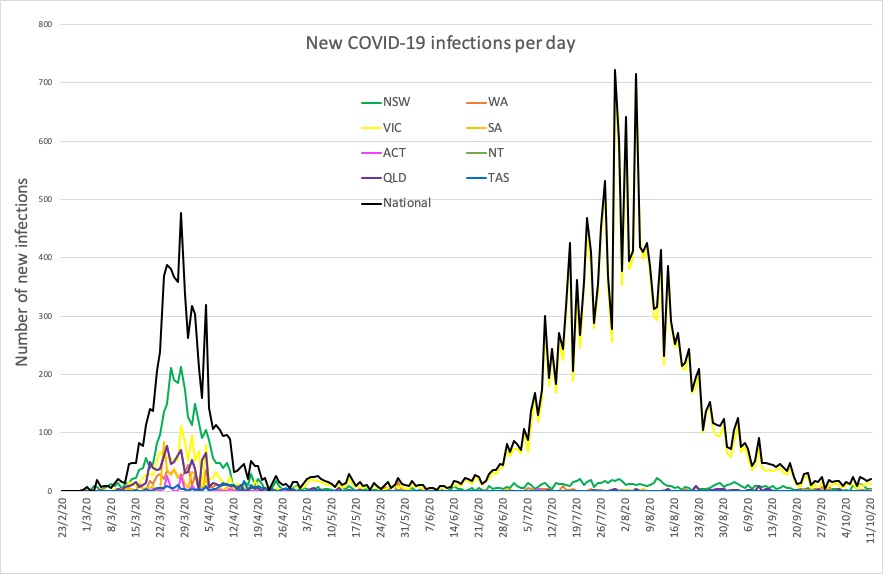CSIRO research suggests the virus could survive on surfaces such as glass, steel and banknotes for up to 28 days under certain conditions.
Welcome to The Medical Republic’s COVID Catch-Up.
It’s the day’s COVID-19 news in one convenient post. Email bianca@biancanogrady.com with any tips, comments or feedback.
12 October
- Study finds SARS-CoV-2 survives on non-porous surfaces for up to 28 days.
- Pandemic boosts interest and investment in bicycling and cycle infrastructure.
- Daycare nursery in Poland documents outbreak among children.
- COVID-19 the third-leading cause of death in the United States.
- UK’s Test and Trace system missed nearly 16,000 index cases.
- The latest confirmed COVID-19 infection numbers from around Australia.
- You have to hand it to SARS-CoV-2: it’s a persistent little bugger. CSIRO research suggests the virus could survive on surfaces such as glass, steel and banknotes for up to 28 days under certain conditions.
A study published in Virology Journal examined the survivability of SARS-CoV-2 by inoculating a range of surfaces at different temperatures, but kept in the dark to avoid the impact of UV light. The inoculant concentration was similar to what would be found in body fluids of an infected person.
At 20 degrees Celsius, infectious virus could still be detected on all the non-porous surfaces (glass, stainless steel, vinyl, plastic and paper banknotes) 28 days after inoculation, and it could be detected on cotton up to 14 days after inoculation.
At 30 degrees C, the virus could be recovered from non-porous surfaces up to seven days after inoculation, but at 40 degrees C, it didn’t survive longer than 48 hours on non-porous surfaces.
The authors commented that persistence on bank notes was significant because of the potential of these surfaces to carry the virus a long way and to lots of people. Its survival on glass was an issue for touch-screen surfaces, for example bank ATMs, mobile phones and airport check-in kiosks. - There are few silver linings to be found in a devastating global pandemic. One small but significant one is the surge in interest and investment in bicycling, as people shun public transport for fear of COVID-19.
The European Cyclists Federation has been tracking the impact of COVID-19 on measures such as additional investment in cycling promotion, additional car-free sections in cities, and new cycleways (and clearly have a data whiz on staff who has generated some impressive visualisations).
According to a report in Statista, the ECF’s analysis has found that more than one-third of the EU’s biggest cities have taken some COVID-19-related action to boost cycling, spending more than €1 billion and building more than 1000 kilometres of new cycling infrastructure since the start of the pandemic. Finland, Italy, France and the UK are the top four investors, but Australian cities are also getting on their bikes: Melbourne recently announced an additional 40 kilometres of kerbside protected cycleways. - A single case of COVID-19 at a daycare nursery in Poland resulted in a cluster of 29 cases, eight of which were children and 12 of which were family members who did not directly enter the facility, a study has found.
A report in Emerging Infectious Diseases documented the outbreak, which occurred over 14 days after pandemic lockdown lifted in Warsaw. An average of 25 children attended the nursery each day for approximately eight hours. They were divided into three groups, each with two carers, and the children and carers did not move between groups. The staff all work face masks when in contact with the children, parents were not allowed into the building when collecting their children and had to wear masks during pick-up and drop-off.
“The high infection attack rate among children in our cluster could be explained by prolonged close contact between very young children, who are less able to adjust to control measures,” the authors wrote. “Moreover, the airborne transmission route in the nursery rooms’ confined environment could have played an important role.”
The authors also noted that most of the children were asymptomatic, and suggested more research was needed to clarify the role that young children can play in transmission of COVID-19. - COVID-19 is now the third leading cause of death in the United States, surpassed only by heart disease and cancer. It has claimed more US lives than any conflict except World War 2 and the American Civil War, Scientific American reports.
- The UK’s contact tracing regime is under fire after the details of nearly 16,000 cases of COVID-19 weren’t transferred to the NHS’ Test and Trace Service, according to a report in the BMJ.
Since the error was discovered, extra contract tracing has been carried out, but the report said only around half of those potentially exposed to the infected people had been reached by the contact tracers. - Here are the latest confirmed COVID-19 infection numbers from around Australia to 9pm Sunday:
National – 27,264, with 898 deaths
ACT – 113 (0)
NSW – 4277 (5)
NT – 33 (0)
QLD – 1161 (0)
SA – 475 (2)
TAS – 230 (0)
VIC – 20,281 (12)
WA – 694 (2)




